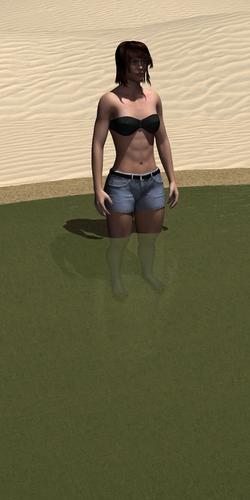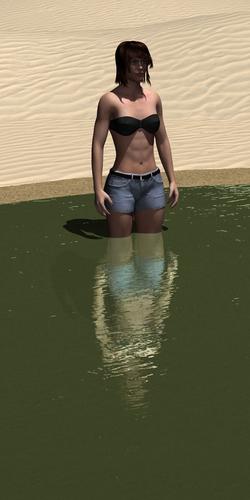Loss of Reflection
Hi,
I created an environment with a small waterpond. As well known, water creates refraction for the light transiting between the water and the air above. And the view of each object above the water surface is reflected to the camera.
In DAZ it is possible to use both effects.
But:
As soon as I set up refraction, the reflection is lost (almost).
Is this a problem of DAZ / rendering engeene or are there other aspects?
I append two pictures showing the pure reflection (OK, 100% is a bit too strong but ...) and the effect when I additionally switch on the natural refraction.
Andy


Water_with_refraction.jpg
1000 x 2000 - 248K


Water_with_refraction_0.jpg
1000 x 2000 - 236K


Comments
What is the Maximum Ray Trace Bounce setting in the Advanced tab of render Settings? Both refraction and reflection in a surface will use one bounce.
Sorry Richard,
don't know, what you're talking about.
I'm new to DAZ - so sorry for it.
It is still the DAZ 4.6 standard setup as it was delivered.
What bounce should be set?
Andy
I could be wrong, but check if your Max Ray Trace Depth is set higher than 1.
In my render, MAX Ray Trace Depth from left to right: 1, 2, 6
Here is an example of render settings. You adjust you raytrace setting in there
Actually I didn't look closely enough - since you do have a weak reflection it's unlikely the issue is ray trace depth. Refraction does weaken the effects of reflection, and I don't recall its being quite like that before.
Try using ubeSurface instead of the default DAZ Shader - \Shader presets\Omnifreaker\Uber Surface in your DAZ Studio Formats content library, use the Surface Selection tool from the Tools menu to select the plane, then hold down ctrl (cmd on the Mac) and double click the base file in the Content Library and select Ignore for maps. In the Surfaces pane you will need to turn Reflection and Refraction on and adjust the settings but you should get stronger reflections with refraction active than you do with the default shader.
Hi Richard,
changing the "ray trace depth" doesn't influence the effect Default setting is 2. I also observed, that activating refraction overwrites the opacity setting. This somehow looks like nonsense as it is that dramatically changing the reflection effect. But perhaps the author of DAZ had a contrary intention. - Or it is a huge BUG. :-S
Next point:
I allready purchased a lot of addons. But still there isn't any shader preset in my library. In the standard setup there is only the omnifreaker ÜberAreaLight. And this works in a totally contrary way as one expects it would. But this is a different topic what we first should discuss in PMs, because what I found out up to now is really strange.
So please what is that about the omnifreaker shader presets?
Andy
Added to what has been said already you could try
Daz Default Surface: Turn OFF Multiply Specular Through Opacity
Uber Surface: Turn Off Multiply Reflection Through Opacity
Hi Pete,
so far this measure brought a little positive effect. Thanks for the hint.
But in general the current reflection handling (with active refraction) is way too weak.
Andy
so far this measure brought a little positive effect. Thanks for the hint.
But in general the current reflection handling (with active refraction) is a violation of the physics of optics.
Andy
Just keep in mind that 3Delight rendering doesn't really have that much to do with physics of optics - in some parts it is close in others not so much. So you will have to accommodate a bit and learn to live with 3Delight quirks. If you want more physical accurate renders there are different render engines that are more close to what you see in nature everyday, like LuxRender or OctaneRender.
Sorry,
I had to correct myself.
Most of it is correct.
Now, as I understood right, it not a question of DAZ - it is more a wise selection of the render engine?
It is not a question of render engine but of what the actual surface shader is doing
As Richard said, you should apply Ubersurface on the water instead of using the Default DS Shader which has weak reflections when refraction is active. Ubersurface seems to do it better. You should find it in My Library\Shader Presets\omnifreaker\UberSurface as it comes free with DS. You may have to download "Default Lights and Shaders for DAZ Studio" if you don't find it (Look in your Product Library at Daz Studio Pro)
My test with ubersurface below
I'm guessing: you have an image in the Bump channel. ( might even be named ACQ0005.jpg)
Put the same image also in the Displacement channel, turn up the values, render and see if the reflections are there again...
Hi Takeo,
I tried to remove the bump pattern. But at your steep angle I don't get that intense reflection you're showing.
At low angles, my reflections are satisfying allready.
I know it depends on a lot of paramaters. And with every hint over here I succeed better.
Is it perhaps possible to generate a text list of the parameters for the water surface?
A further question:
The ÜberSurface Shader Presets are available in the content library list. But how to apply it to my water surface?
At the moment I used a simple plane to present the water. Is it a different method to use the ÜberSurface instead?
Think, here I need a little coaching. ;)
Andy
To apply a shader you have to select the object in the scene tab, then select the surface you want to apply the shader
Then double click on the "ubersurface base". That will apply the base ubersurface shader
Once you got the shader applied you just have a few parameters that are important for reflection and refraction :
1 - In opacity, put the opacity under 100% (I think around 50% should be good but it's up to you)
2 - Activate the Refraction
3 - Activate reflection
4 - Change reflection to Raytrace
5 - eventually change the reflection color (I've changed mine to red so that you can see what it makes)
You can tweak as you like after that. The other parameters like diffuse, ambiant, specular will have an impact on the rendered effect
Hi Takeo,
ah yes, thank you.
And yes, the ÜberSurface makes a very intense reflection.
But here - now you may think I'm never getting satisfied ;) - that kind of reflection is not usefull for liquid surfaces.
The optical effects are almost correctly realized within the standard DS shader - only a little too weak. In nature for steep angles you have a clearly visible reflection. If you decrease the angle of view to very low angles the reflection intensity increases dramatically up to 100%. And this is correctly reproduced by the standard DS shader too. The author of that feature only forgot that it goes with the lg-function for the human eye.
But the ÜberSurface shader ever has the same reflection intensity independant of the angle of view. So for liquids like water this is not correct. For other objects / surfaces this is very suitable.
OK, so one has to choose the best way for the specific situation. And adopt some of the parameters for the respective render.
Andy
OK, didn't know that. Learned something usefull.
So if you think the DS Default shader is better for what you want to do you can simply override the default 200% strength limit and put it at whatever you feel like
Apply your default DS shader and go to reflection strength and click on the little wheel right of the parameter, then on "surface parameter" and put the max at 2000% for example, then tweak your strength until satisfied